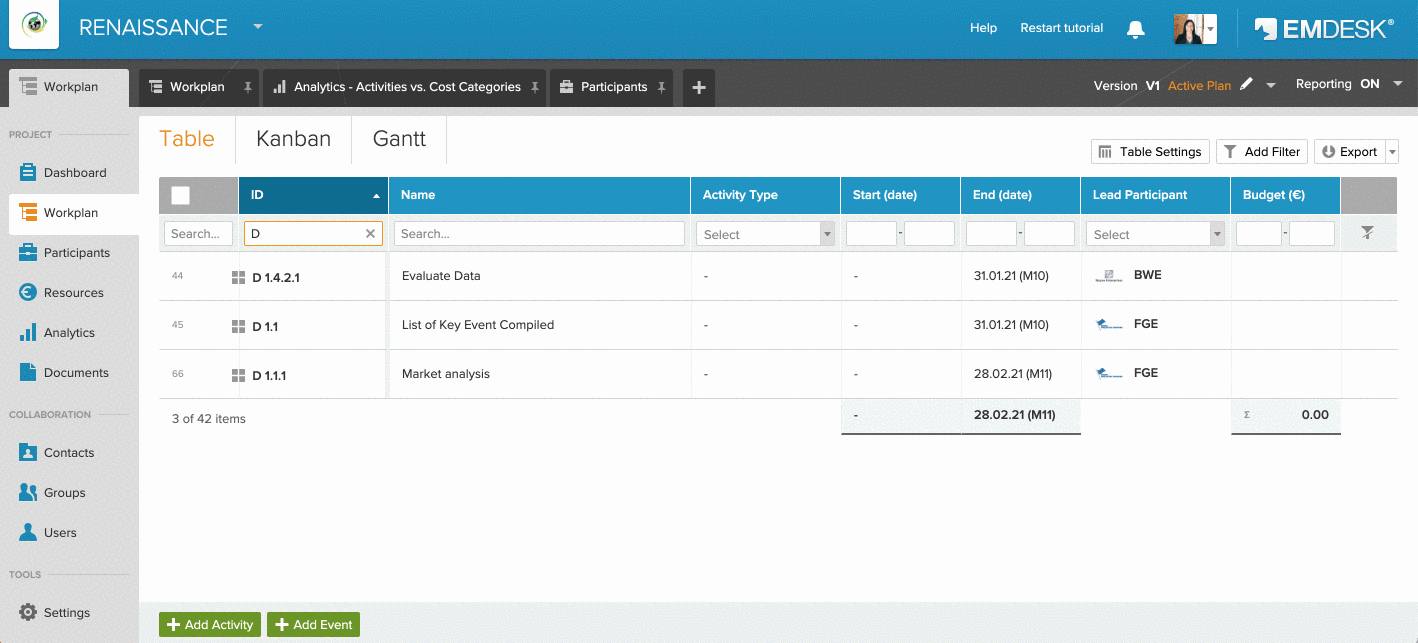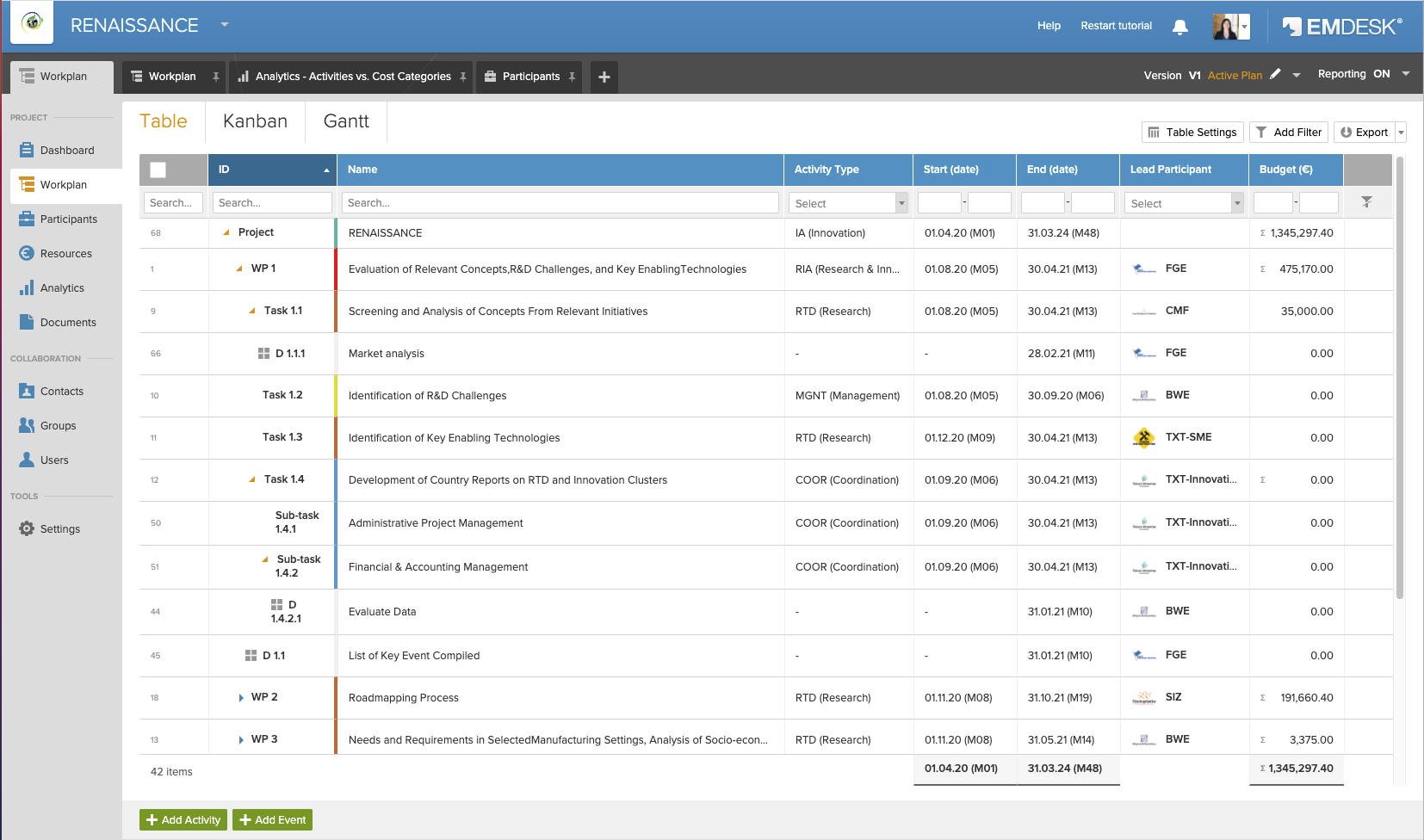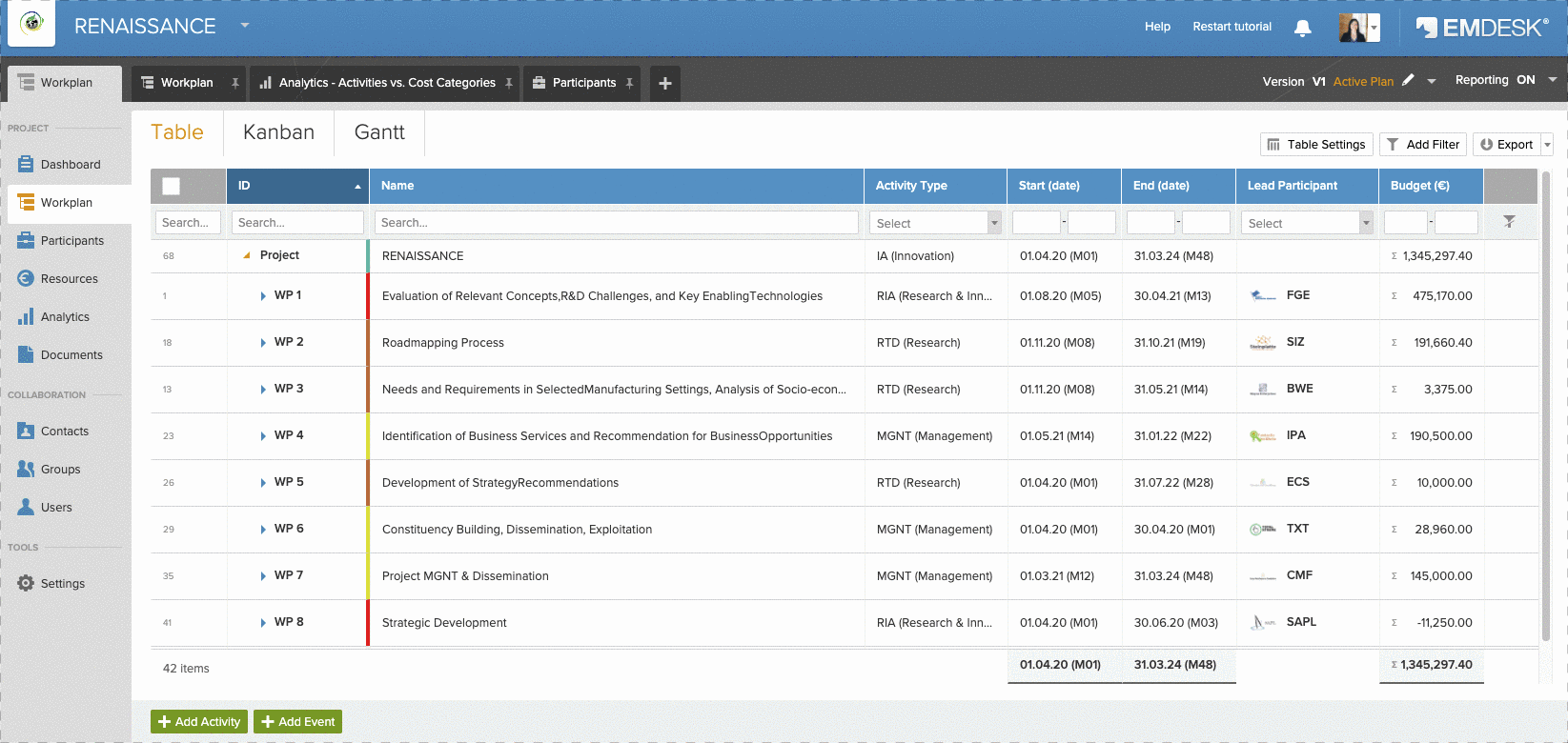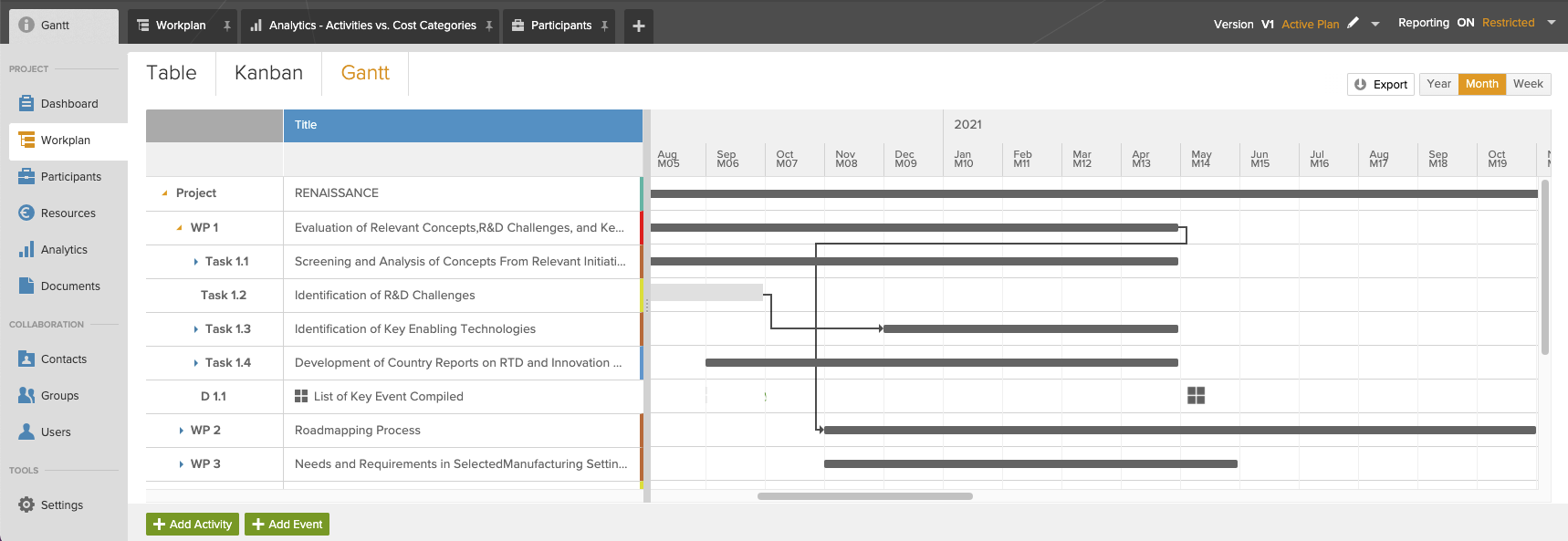One of the biggest parts of preparing the Implementation Section of a Horizon Europe proposal is planning out the project details and developing your project's work plan. The best way to go with developing a Horizon Europe Proposal work plan is by breaking the work down into easier manageable pieces. Once you have your list of tasks, you can start by estimating who will work on those tasks, how long they’ll take, how much they’ll cost, etc.
Creating a productive schedule will require you to consider which tasks depend on one another, and what those dependencies are. You’ll need to keep in mind how many resources will be available and when in order to properly schedule the timing of each task. A successful Horizon Europe Proposal work plan is something that can be used throughout the lifecycle of the project. It will be used as a means of progress tracking and helping you direct the people working on the project. In this article, we go through the main steps of a work plan's development process.
Step 1. Set the project’s goal and objectives
A first vital step to creating an effective work plan is determining and defining the overall goal of your project. Simply put, the project goal is the end result that you would like to deliver. The project goal should be something like a problem to solve or an opportunity that can be beneficially acted upon.
Keep in mind that your project goal must be aligned with the missions of the Horizon Europe programme. The goal must help to achieve the political agenda of the Horizon Europe Programme. The project goal needs to drive everything that happens in the project, so it’s important to use enough time to develop a solid goal that’s in line with programme missions.
Since the goal is the foundation by which everyone can see if the project is on the right track or not, it’s imperative that major stakeholders and partners are actively involved with the development and final decisions regarding the definition of the project's goal. Once the project’s goal has been set it can be further fleshed out by identifying more detailed objectives. These objectives will help define the scope, deliverables, and success criteria that must be met in the project. It’s important that both you and your partners keep the project goal in mind over the lifecycle of the project in order to check if it's still feasible or not.
Step 2. Identify the project’s deliverables
After setting the overall goal of your project, it’s time for you and your project team to evaluate which steps are necessary to achieve the project’s goal. This can be done by planning your project deliverables.
Project deliverables are the results that a project will deliver and/or outputs that must be produced at a given moment over the course of the project. Keep in mind that deliverables can be tangible or abstract. Some examples of tangible deliverables would be a technical diagram brochure, a new product, or a research manuscript. Abstract deliverables can be things such as improved results.
Deliverables will help you define what to include and leave out of the project. They will also help you measure the progress of the project once it’s underway.
Pro tip: Start by documenting your project deliverables by listing the deliverables at the end of the project first. You’ll find it much easier to begin the documentation process by thinking about the results your project will deliver.
Using EMDESK’s single solution project management tool, you can effortlessly document deliverables in real-time. Quickly and easily enter your deliverables in collaboration with all your project teams into a single cloud based programme. Allow you and your teams to save time and have more productive discussions:

Step 3. Create work packages
Once you and your project team have identified and documented your deliverables, you’ll need to consider how the deliverables can be achieved, and start to discuss the scope of the work. The best way to go about this step is to identify activities that have to be done and create project tasks with your project teams.
This time you’re going to start at the top with top level tasks and work your way down in order to build the work breakdown structure. The best way to go about this is to use deliverables to identify the top level summary tasks.
Keep in mind that collaborative Horizon Europe projects can consist of hundreds of tasks, and that some of those tasks will be interconnected or depend upon the success or completion of other tasks. This is the reason for grouping and organising your tasks in work packages (WPs). WPs help you to divide up project work and tasks into more manageable parts.
WPs are usually high-level tasks that help to summarise work in some way and describe different parts of the project. For example, they could represent phases of your project or different areas of work (e.g. research, management and dissemination, or work done by different project teams). Once you have your WPs you’ll need to break them down into tasks. If the work of any one task is very detailed you’ll need to break these tasks down further into subtasks. This work breakdown structure of Work Package > Tasks > Subtasks will help you plan, track, manage the project. The main benefits of this structure are:
- An easier estimation of time and costs, particularly for smaller sections of work.
- A clearer view of who should be assigned what work and to which team members.
- Built-in checkpoints to measure progress of the project.
It’s important to engage all major project stakeholders in the process of identifying the top level tasks / WPs. Projects have many moving parts and are a lot of work so it can be easy to overlook something. By including stakeholders in the WP and top tasks process you’ll be able to make sure that everything and everyone has been properly included, and that no work has been overlooked. Being inclusive will also foster an environment that’ll help partners and teams remain motivated throughout the project by having a participatory role and voice in the work planning process.
Once the top level tasks / WPs have been chosen, you can work in smaller groups to break the tasks into smaller pieces. This process will likely have several iterations as new activities are identified, grouped, or broken down into smaller tasks. The process may also result in re-aligning the entire work breakdown structure. At the end of this process it’s important to have everyone together again in order to review the structure and correct any issues.
As you’re in the final stages of the task breakdown process, you’ll need to start thinking about the expertise and skills each task and your project requires. You’ll need to identify which expertise is needed for different parts of the project and how many people you need with those skills in order to have a foundation to estimate the resources and personnel costs. Once this has been done, you’ll have the information you need to start assigning tasks to specific project participants, teams, and partners.
Teamwork is a vital part of developing a successful Horizon Europe proposal work plan. By ensuring that teams and stakeholders actively participate in the work plan development process, you’ll have a higher chance of creating a schedule that’s able to realistically reflect the work to be done, timing, resources, estimated costs, and the project end or delivery date. In addition to increasing motivation throughout the project, teamwork in the development stage will require less planning and communication during the run-time of the project as everyone will have a clear idea of what needs to be done.
Another key to success is having a powerful tool that allows you to develop, plan, communicate all in one place. EMDESK’s work plan designer with customisable views and communication features (including real-time discussions and video calls), allows your project teams and partners to effortlessly design and revise WPs. EMDESK gives your teams what they need to work together in a focused, transparent, and timely manner.
Using EMDESK as your project’s all in one management solution will help you to stop the cycle of endlessly long meetings, overflowing inboxes, and redundant communication. EMDESK gives you the tools you need to streamline your project development process with intuitive and secure collaboration methods. Real-time views mean that everyone can review the latest draft of the project schedule at any time. Allowing teams and stakeholders to provide input and feedback on the latest version by making updates and comments, with full audit logs. Here is an example of a project work plan developed using EMDESK’s platform:

In addition to your teams, you may also have experts, reviewers, outsourcing, subcontracting, and partnering arrangements. It’s important that these groups aren’t forgotten and are also added to the relevant tasks. EMDESK’s free guest user feature allows you to invite these participants to the project with access just to their specific tasks.
Pro tip: Describe the work that needs to be done in detail to all your team members. Task work descriptions should be detailed as clearly as possible and have a clear objective. It's always better to provide a bit more information than not enough about the work that needs to be done. The more information you give – the less questions you will get.
With EMDESK, you can easily take control of every activity in your work break down by entering clear descriptions and objectives. There’s even the option to link other relevant specifics for the work description and / or attach documents to tasks, as well as leave comments and discuss tasks in real-time:

A work package plan does more than describe the work, it also identifies how you know the task is complete and whether it was completed correctly or not.
Pro tip: Consider breaking the work down to match the frequency of your status reports. This will allow you to have measurable progress and completed tasks for every status report.
